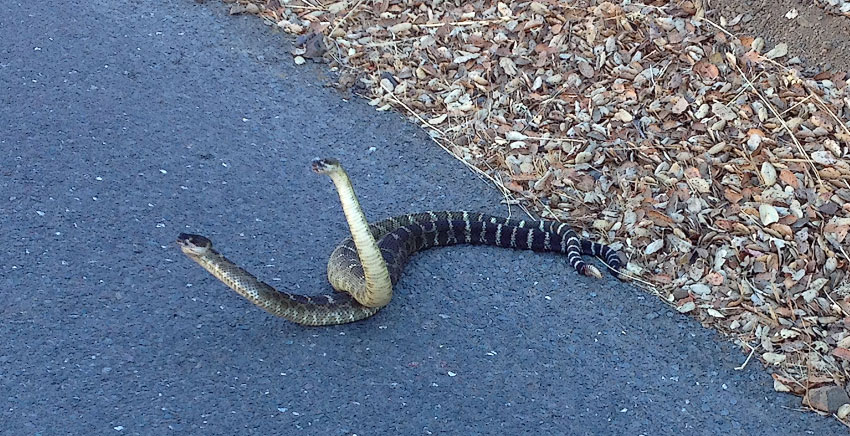Rattlesnakes in Love
No, I’m not talking about sex and politics.
Update: according to readers, these are two male rattlesnakes vying for dominance. See comments that follow.
I was out on my daily bike ride and came across two rattlesnakes fully intertwined and erect to a greater height than seen here. I would assume a male and female mating behavior, but this being near San Francisco, one can never be too sure.
One snake appeared to have 6 or 7 segments in its rattle, the other 10-12. My understanding is that each segment represents roughly a year of age.
I would have liked to have gotten a lot closer, but I kept my distance. And my main goal other than getting a few snaps was to shoo them off the road, as I see squashed snakes all the time near here. I rather like them—at some distance—and I had never seen such mating behavior before.
Related: rattlesnake head shot | imposter (gopher snake). As an interesting note, my understanding is that King snakes eat rattlesnakes.
The iPhone 4S produced its usual blurred mis-focused dreck; this is heavily cropped and strongly sharpened still photo (best of 4).

iPhone 4S
Dan M writes:
As a former curator of reptiles and amphibians, I thought I'd put in my two cents.
Actually, the higher chance is that it is two males in "combat dance", in which each snake tries to loop its neck above the neck of the other snake and push it to the ground. It's thought to be a method of controlling territory.
No, a rattlesnake adds a rattle each time it sheds it’s skin. This can happen 2-4 times a year, depending on a variety of factors. The more food, the more the snake grows, the more it sheds. So in a good year with plenty of food supply, a rattlesnake might add 3-4 rattles in a single year. If any snake sustains a significant injury, say, a deep cut, the injury will trigger a much faster shedding cycle, which aids the wound healing process. So if a rattlesnake is injured and goes through this increased shedding, there will be more rattles added in that year.
Older rattlesnakes usually lose the "button" rattle they're born with and some of the ones behind it, just through wear and tear or hitting the rattles against something as they are being rattled. This makes a flat, stubby end to the stack of rattles. Younger snakes still have the full tapering set of rattles that get smaller and smaller toward the end, terminating in the original button, as appears to be the case for the one in your photo whose head is to the right. The other one seems to have lost the end of his rattles and the ones remaining are exactly the same size, which indicates some age. Tough to guess at his age, but the younger one might be four years old, maybe five. The button is not to be confused with the internal part of an old rattle that is exposed when the rattles beyond it are broken off; after you've seen both in photos you won't confuse them.
Your rattlesnakes are Northern Pacific Rattlesnakes, Crotalus oreganus oreganus. You don't want to be bitten by one, for their size, they're fairly toxic. The older the snake, the more venom, obviously, but the toxicity declines drop for drop, slightly. So the worst would be one in its prime, say maybe 4-6 years of age that's had a good supply of food all that time. Of the 32 varieties of rattlesnakes within the United States, they along with the southern variety are among the worst for living in very close proximity to humans. They'll set up shop in crevasses within rocky outcrops right around houses, driveways, access roads. Some folks who've built innovative homes into ridges have had Pacific rattlesnakes living in parts of the structures of their homes. They are not especially aggressive, but you don't want to be careless about walking past bluffs too close, or sticking your hands into crevasses.
Most of these guys top out at three to three and one half feet in some parts of their range, less in others. Snakes can strike effectively about a third their length. so if you pad that excessively to 2-3 times their length, you should be OK. This is for a snake that is NOT agitated and not moving. If it's on the move or pissed, allow a good deal more distance.
... continues ...
And, as you could see from the herp web site, Crotalus oreganus oreganus has essentially the same pattern throughout its range, but varies tremendously in the color of that pattern. This makes sense; the Northern Pacific rattler lives in just about any habitat in its range that has a decent amount of rainfall, so the snake has to blend into the surface background of whatever habitat the population inhabits.
Way back fifty years ago Carl Kauffeld and his Staten Island Zoo staff were the first zoo to get all 32 subspecies on display. The last to join the collection was Crotalus concolor, the midget faded rattlesnake from Utah, Colorado, which gained fame in Edward Abbey's Desert Solitaire. Here are absolutely perfect specimens.
DNA work has awarded the Northern Pacific separate species status, but its also reshuffled the old "32 subspecies in the U.S. " notion, so you'll see differing accounts of just how many species, subspecies there are in the States.
Some squirrels in California have evolved at least a partial immunity to the venom. The immunity seems to be almost rattlesnake population specific.
You'll also read a lot about the neurotoxic elements of the southern subspecies, helleri. It's venom destroys tissue and prevents blood clots, in addition to having neurotoxin qualities. Exactly how neurotoxic it is seems to be a subject of some debate these days.
When you're doing your photo trips to Death Valley, you're brushing up against the habitat of the Panamint rattlesnake, C. mitchelli stephensi. Not sure all of these below are panamints. Most of the smaller ones are:
Look at the pink one from Inyo County (two Joel Lingenfelter photos lower left that site). Years ago I had one in captivity with that coloration. One of the most beautiful rattlers I've ever seen. Many of them have the black flecking bordering the dorsal blotches. One I had sported a perfect ring of flecks around each blotch, and the deep pink tint over the whole body.
If there's pavement at higher altitude, look for them to be out on the pavement 30 minutes to 3 hours after sunset.
DIGLLOYD: I do generally avoid sticking my hands into crevices.
Jon L writes:
Cool shots. The medical symbol is called a "Caduceus".
Mark C writes:
Very nice observation; I'm a little envious. A few comments: I'm not 100% sure, which would require being a bit too intimate with these snakes, but it's probably not mating behavior. Instead, it's most likely two males wrestling, presumably for dominance, which is a common behavior in rattlesnakes. They never bite each other, by the way, despite being in a fight of sorts. THe mating snakes I've seen are pretty calm and quiet.
Odd fact: snakes have two penises, which are 'inflated' out of the cloaca, one on each side, when circumstances are appropriate.
The species is the western rattlesnake (Crotalus oreganus). Western diamondbacks (C. atrox) tend to be quite a bit bigger and (in CA) are only found in the lower Colorado desert, around the Salton Sea and farther east. FYI, some photos of western diamondbacks are on this page : https://faculty.ucr.edu/~chappell/INW/herps/westerndiamondback.shtml
The rattles acquire a new segment at every shed (which most snakes do several times per year), but they wear/break off over time.
DIGLLOYD: yes, those photos look significantly different than what I saw in coloration and pattern.
James S writes:
While there was a female rattlesnake somewhere nearby, the two in your photos are males. The weaker of the two would've retreated after the wrestling match and the dominant male would've mated with the female.
DIGLLOYD: exactly what happened: one retreated. I never saw a 3rd snake though.























